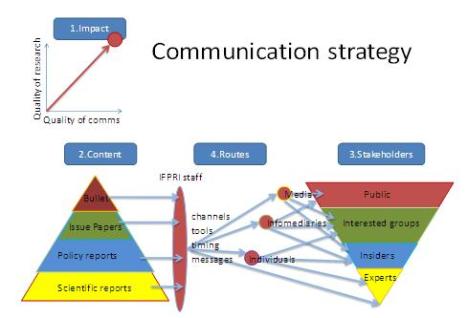Reviewing how our web strategy matches our communications strategy has provided some interesting insights into how we can use the web more effectively. The use of the web needs to address the key requirements raised by the four components of the overall communications strategy.
IMPACT
In the first element the quality of research can be measured by the use of a number of web based tools, for citations, comments and uptake. The Quality of the communications may be split into two components; the quality of the product (content, style, format), and the quality of the promotion (process).
CONTENT
The web provides many opportunities for the storage of content, not just physically on the website, but increasingly on repositories elsewhere. Videos are stored on YouTube, presentations on SlideShare and photos on Flickr. These don’t just serve as places to store materials, but are places where people search for materials and so promote as well as providing access to content.
STAKEHOLDERS
The stakeholders are looking for information on the web in different ways. Potential contacts can be identified on the web for individual campaigns; they have their own communities of practice online. They can be reached through our existing site, by email, but increasingly through social networks.
ROUTES
The fourth component of the strategy is focused on how to reach the stakeholders, not only through IFPRI’s own efforts directly, but also through intermediaries, be they the media, the growing band of infomediary organizations or through individual champions or thought leaders.
The Web presence
To build a web presence to fulfill these requirements we need to look at the roles we need to play. These seem to fall into seven categories:Building the capacity of staff to use and publish on the web; Setting up systems to capture content; Publishing this information on web platforms; using social media to publish and promote to different audiences; indexing our materials so that they can be presented in context and easily found; disseminating content through feeds and email and promoting our products through inclusion in other sites, directories and infomediaries.
Web platforms
The web platforms include the Website, Portals, Blogs and Group spaces. We build these services on the same platforms ensuring possible integration of content and ease of maintenance. The portals address very specialized audiences and so vary considerably in their functionality. They are usually a hybrid between an online service and an e-publication. With such a diversity there are new challenges for featuring content across platforms, integration and cross searching.
Promotion
In addition to normal marketing activities we have used a number of more automated methods of promotion, such as indexing in Google using sitemap, blogsearch, google scholar and OAISTER through the production of OAI files. Registration in infomediary directories and sites is another route being developed in line with the communications strategy.
Social media
Through using Twitter, Facebook and LinkedIn new communities of users have been reached and by integrating these services through the use of feeds we have new ways to disseminate information about events, publications and projects. The Youtube and Slideshare accounts host our videos and presentations and bring visitors back to related information on our website.
Indexing
Indexing becomes essential as web materials are no longer held on one server, nor are they only viewed through the website. Each page, video, document, presentation or article needs to be indexed so that it can be presented to all the potential audiences through their preferred interface.
The indexing is essential for three reasons:
Being found/Promotion:Therefore for those users reliant on Google, the work done by the library in submitting all publications to Google scholar is essential, the sitemap from the website and the feeds from the site all ensure that our materials are found.
Sending/Dissemination: The indexes are used to generate feeds by topic, country or type, with the potential to deliver to audiences through a range of systems, via Twitter, by email, through web pages, embedded in a blog, viewed through a newsreader.
Providing a search interface: The indexes used provide act as search engines with metadata to control the quality and relevance of results. This can also present lists by keyword or tag, to present lists of materials through the main website.
Dissemination
In addition to the email newsletter New at IFPRI, we have worked to reorganise materials around topics and countries. For the thematic pages we have also used the taxonomy to produce feeds. RSS and email subscriptions have have been consolidated in one reference page for subscribers at http://www.ifpri.org/rss
Filed under: Strategy | Tagged: audience, communications strategy, web 2.0 |



Leave a comment